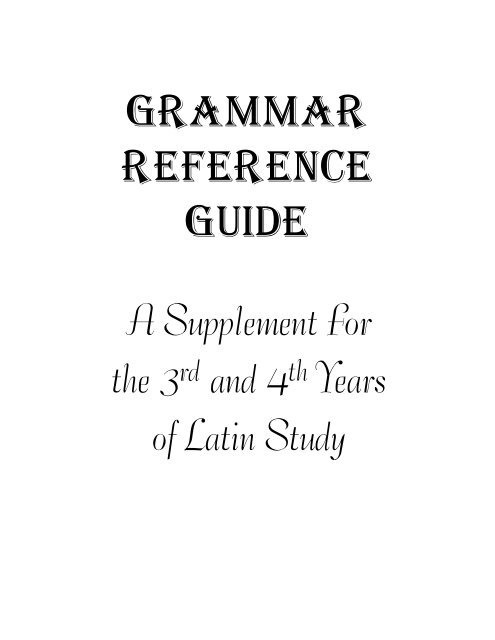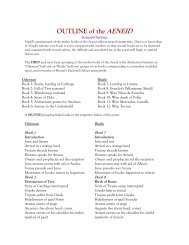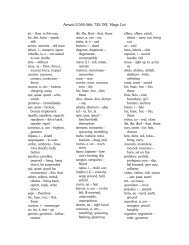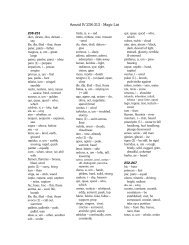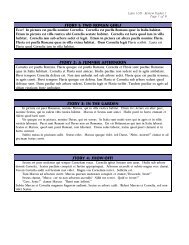GRAMMAR REFERENCE GUIDE - Homestead
GRAMMAR REFERENCE GUIDE - Homestead
GRAMMAR REFERENCE GUIDE - Homestead
Create successful ePaper yourself
Turn your PDF publications into a flip-book with our unique Google optimized e-Paper software.
<strong>GRAMMAR</strong><strong>REFERENCE</strong><strong>GUIDE</strong>A Supplement Forthe 3 rd and 4 th Yearsof Latin Study
Grammar ReferencePage 5DEMONSTRATIVESDemonstratives can be either pronouns (standing alone)or adjectives (modifying a noun)A DEMONSTRATIVE POINTS OUT SOMETHING OR SOMEONEThe FormsIS (this, that) and IDEM (the same)SING Masculine Feminine Neuter Masculine Feminine NeuterNominative is ea id idem eadem idemGenitive eius eius eius eiusdem eiusdem eiusdemDative ei ei ei eidem eidem eidemAccusative eum eam id eundem eandem idemAblative eo eā eo eodem eādem eodemPL Masculine Feminine Neuter Masculine Feminine NeuterNominative ei eae ea eidem eaedem eademGenitive eorum earum eorum eorundem earundem eorundemDative eis eis eis eisdem eisdem eisdemAccusative eos eas ea eosdem easdem eademAblative eis eis eis eisdem eisdem eisdemHIC (this, these) and ILLE (that, those)SING Masculine Feminine Neuter Masculine Feminine NeuterNominative hic haec hoc ille illa illudGenitive huius huius huius illius illius illiusDative huic huic huic illi illi illiAccusative hunc hanc hoc illum illam illudAblative hoc hāc hoc illo illā illoPL Masculine Feminine Neuter Masculine Feminine NeuterNominative hi hae haec illi illae illaGenitive horum harum horum illorum illarum illorumDative his his his illis illis illisAccusative hos has haec illos illas illaAblative his his his illis illis illisNOTE: The demonstrative iste declines just like ille,as does the intensive adjective ipse.
Grammar ReferencePage 10Verbs – TerminologyConjugation: group or category of verbs – there are 4 conjugationsTenserefers to time of action• present – happening NOW• imperfect – repeated, habitual PAST action• future – happens in FUTURE• perfect – completed PAST action• pluperfect – PAST action relative to another PAST tense verb• future perfect – completed action in the futureMoodrefers to the speaker’s frame of reference or frame of mind• indicative – simple declarative statement of fact• subjunctive – expresses hope, doubt, fear, wishing – more subjective• imperative – command• infinitive – absolute form of the verbVoicerefers to the performance of the verb’s actionactive – subject of verb performs the actionpassive – subject of verb is the recipient of the actionPersonWHO the actor or subject is1 st person – I (singular), we (plural)2 nd person – you (singular), y’all (plural)3 rd person – he, she, it (singular), they (plural)Numbersingular – one person or thingplural – more than one person or thing
Grammar ReferencePage 11Principal Partssequor, sequi, secutus sum (note: for deponent verbs, theforms must be passive)INDICATIVEACTIVE PASSIVEPRESENTIMPERFECT2 NDFUTUREPERFECTPLUPERFECT 3 RD 4 THFUTURE PERFECTSUBJUNCTIVEPRESENTIMPERFECT2 NDPERFECTPLUPERFECT3 RD 4 THINFINITIVESPRESENT2 NDFUTURE4 THPERFECT 3 RD 4 THPARTICIPLESPRESENT2 NDFUTURE 4 TH 2 NDUnderstanding verb forms in Latin depends on knowing how to use and recognize principal parts.Every Latin verb has principal parts. Regular verbs have 4, deponent verbs have 3.amo, amare, amavi, amatus1 st principal part – 1 st person singular, present active indicativedictionary entry2 nd principal part – present active infinitivedetermines conjugationused to form all tenses, active & passive, in the PRESENT SYSTEM3 rd principal part – 1 st person singular, perfect active indicativeused for PERFECT ACTIVE forms4 th principal part – perfect passive participleused for PERFECT PASSIVE forms
Grammar ReferencePage 13PERFECT ACTIVE SYSTEMALL verbs form the perfect ACTIVE tenses in the same wayBuild on the PERFECT STEMPerfect Stem: 3rd principal part - I (blind the Cyclops)The ENDINGS show what TENSE & MOOD the verb isPerfect Active IndicativePerfectPluperfectFuturePerfect1 st S i eram ero2 nd S isti eras eris3 rd S it erat erit1 st P imus eramus erimus2 nd P istis eratis eritis3 rd P erunt erant erintPerfect Active SubjunctivePerfect Pluperfect1 st S erim issem2 nd S eris isses3 rd S erit isset1 st P erimus issemus2 nd P eritis issetis3 rd P erint issentThere is nofutureperfectsubjunctivePerfect Active Infinitiveisse
Grammar ReferencePage 14PERFECT PASSIVE SYSTEMALL verbs form the perfect PASSIVE tenses in the same wayHELPING VERB: A FORM OF SUMWhen HELPING VERB is PLURAL, 4 th principal part becomes pluralThe TENSE AND MOOD OF THE HELPING VERB show what TENSE & MOOD the verb isPerfect PASSIVE Indicative - Helping VerbsPerfect (presentindicative ofsum )Pluperfect(imperfectindicative ofsum )Future Perfect(futureindicative ofsum )1 st S sum eram ero2 nd S es eras eris3 rd S est erat erit1 st P imus eramus erimus2 nd P istis eratis eritis3 rd P erunt erant erintPerfect PASSIVE Subjunctive - Helping VerbsPerfectPluperfect1 st S sim essem2 nd S sis esses3 rd S sit esset1 st P simus essemus2 nd P sitis essetisThere is nofutureperfectsubjunctive3 rd P sint essentPerfect PASSIVE Infinitive - Helping Verbesse
Grammar ReferencePage 15SUBJUNCTIVE OVERVIEWSubjunctives follow the same principal parts rules as indicativesPresent System - 2 nd principal part (present & imperfect)Perfect Active System- 3 rd principal part (perfect & pluperfect)Perfect Passive System- 4 th principal part (perfect & pluperfect)The ENDINGS show what TENSE & MOOD the verb isPresent Subjunctivepresent stem + vowel shift + personal endingsvowel changes depending on conjugationCONJUGATION 1 st 2 nd 3 rd 3 rd -io & 4 thVOWEL e ea a iaImperfect Subjunctive2 nd principal part (present active infinitive) + personal endingsPerfect Active Subjunctivesperfect active stem + formula + present system personal endingsPerfectformula: eriPluperfectformula: isseNOTE: Perfect subjunctive looks like future perfectPluperfect looks like perfect active infinitive with endingsPerfect Passive Subjunctives4 th principal part + subjunctive forms of helping verbPerfectpresent subjunctiveof sumPluperfectimperfectsubjunctive ofsumNOTE: Pluperfect looks like perfect PASSIVE infinitive with endings
Grammar ReferencePage 16Sequence of TensesThe tense of the main verb in a sentence determines the tense of the subjunctive in thesubordinate clause.PRIMARY SEQUENCE: Main verb is present, future or future perfectSECONDARY SEQUENCE: Main verb is a PAST TENSE - imperfect, perfect or pluperfectThe tense of the subjunctive in a sentence illustrates time relative to the main verb.Subordinate clause action can happen at the same time as the main verb or before the main verbThis SEQUENCE OF TENSES CHART shows theSUBJUNCTIVE TENSESPRIMARYSEQUENCESECONDARYSEQUENCESAME TIME PRESENT IMPERFECTBEFORE PERFECT PLUPERFECTNOTE: Sometimes a perfect subjunctive is used to show absolute completion of an action insecondary sequence.
Grammar ReferencePage 18Gerunds & GerundivesGerund - Verbal NOUNGerundive - Verbal ADJECTIVESBoth forms are uses of the FUTURE PASSIVE PARTICIPLEMnemonic DeviceGERUND/GERUNDIVE = AMANDUS, A, UMFuture Passive Participle has ND in the forumGERUNDSOccur only in the SINGULAR NEUTER FORMS - if a NOMINATIVE is required, Latin uses theINFINITIVEGEN AMANDI "OF LOVING"DAT AMANDO "TO/FOR LOVING"ACC AMANDUM "LOVING"ABL AMANDO "BY/WITH LOVING"gerundives1st & 2nd Declension Adjective FormsCan take direct object - when that happens, the direct object is usually assimilated into thecase & number of the gerundiveGERUNDIVE IS USED TO FORM TWO CONSTRUCTIONSad + GERUNDIVE to express purposePASSIVE PERIPHRASTIC = GERUNDIVE + form of sum (to express obligation - "must")
Grammar ReferencePage 19CONDITIONALSA CONDITIONAL is an IF/THEN statementIn Latin, there are 6 kinds of conditionalsThe "IF" part starts with SI "IF" or NISI "if not, unless"This is called the PROTASIS of the conditionalThe main clause in the sentence is the APODOSIS.Si eam videt [protasis], laetus est [apodosis].MOODCONDITIONALS - Verb Tenses & MoodsType ofConditionalPROTASIS APODOSIS EXAMPLESimple Present present presentSi eam videt, laetus est."If he sees her, he ishappy."IndicativeSubjunctiveSimple Past any past tense any past tenseFuture More Vivid future futureFuture Less Vivid present (should) present (would)Present Contrary-to-imperfect (were, were to)FactPast Contrary-to-Factpluperfect (had)imperfect (would)pluperfect (wouldhave)Si eam videbat, laetus erat."If he saw her, he washappy."Si eam videbit, laetus erit."If he sees her, he ishappy."Si eam videat, laetus sit."If he should see her, hewould be happy."Si eam videret, laetusesset."If he were to see her, hewould be happy."Si eam vidisset, laetusfuisset."If he had seen her, hewould have been happy."
Grammar ReferencePage 20TRANSLATING finite verbsTRANSLATING indicativesACTIVEPASSIVEPRESENTIMPERFECTIS/ARE _____INGDOES _______________SWAS/WERE _____INGUSED TO ______KEPT _______ING_________EDIS/ARE BEING_____EDWAS/WERE BEING_____EDFUTURE WILL ______ WILL BE _____EDPERFECT________EDHAS/HAVE ______EDDID _______HAS/HAVE BEEN_____EDPLUPERFECT HAD ______ED HAD BEEN ______EDFUTUREPERFECTWILL HAVE ______EDWILL HAVE BEEN______EDTRANSLATING SUBJUNCTIVES (IN SUBORDINATE CLAUSES)ACTIVEPASSIVEPRESENTIMPERFECTPERFECTIS/ARE _____INGDOES _______________SWAS/WERE _____INGWOULDHAS/HAVE ______EDIS/ARE BEING_____EDWAS/WERE BEING_____EDWOULD BE _____EDHAS/HAVE BEEN_____EDPLUPERFECT HAD ______ED HAD BEEN ______EDNOTE: IN SUBORDINATE CLAUSES, THE TENSE OF THE SUBJUNCTIVE SHOWS TIME RELATIVE TO THE MAINVERB, SO TRANSLATION IS ALMOST IDENTICAL TO THE MAIN VERB.EXCEPTIONS - INDEPENDENT USES OF THE SUBJUNCTIVE & CONDITIONALS
TRANSLATING Infinitives & ParticiplesTRANSLATING INFINITIVESGrammar ReferencePage 21ACTIVEPASSIVEPRESENT TO ______ TO BE _____EDPERFECTFUTURETO HAVE ______EDTO BE ABOUT TO_______; INTENDINGT0 _____TO HAVE BEEN_____EDTRANSLATING INFINITIVES IN INDIRECT STATEMENTMAIN VERB IS PRIMARY SEQUENCE (PRESENT, FUTURE, FUTURE PERFECT)ACTIVEPASSIVEPRESENT IS/ARE _____ING IS BEING _____EDPERFECTFUTUREHAS/HAVE _____EDWILL ______HAS/HAVE BEEN_____EDMAIN VERB IS SECONDARY SEQUENCE (IMPERFECT, PERFECT, PLUPERFECT)PRESENTACTIVEWAS/WERE ____INGPASSIVEWAS/WERE BEING____EDPERFECT HAD _____ED HAD BEEN _____EDFUTUREPRESENTPERFECTWOULD ______TRANSLATING PARTICIPLESACTIVE_____INGPASSIVEHAVING BEEN______EDFUTUREABOUT TO _____ABOUT TO BE _____EDMUST BE _____EDTRANSLATING PARTICIPLES IN ABLATIVE ABSOLUTEPrimary SecondaryPRESENT IS/ARE _____ING WAS/ERE ____INGPERFECTHAS/HAVE BEEN_____EDHAD BEEN _____ED
Grammar ReferencePage 22Case Usage - NounsNominativeSubjectPredicate NominativeGenitivePossessionPartitiveObjectiveDescriptionWith certain adjectives; verbs of remembering & forgettingDativeIndirect ObjectPossessionAgent (with Passive Periphrastic)PurposeReferenceWith certain adjectives & verbs (compound/intransitive verbs)Double DativeAccusativeDirect Object (of verbs or prepositions)Duration/Extent of TimeExtent of SpacePlace to WhichAblativeAgentAccompanimentDegree of DifferenceDescriptionMannerMeansCausePlace WhereTime When/Within Which
Grammar ReferencePage 23ParticipleAblative Absolutead + gerundive to express purposePassive PeriphrasticSubordinate Clauses in LatinInfinitiveIndirect StatementIndicativeRelative ClauseTemporal (ut, cum, ubi – “when”)Causal (quia, quod – “because”)Conditionals – Present General, Past General, Future More Vivid – indicatives in the protasis &apodosisSubjunctiveUTPurpose (ne)Result (ut non)Indirect Command (ne)Fear (ne – that; ut – that not)CUMTemporal – whenCircumstantial – when, sinceCausal – becauseConcessive (although – usually will have tamen in the main clause)Indirect QuestionRelative ClauseCharacteristicPurpose (following verbs of sending or going)ResultCONDITIONALSPresent Contrary to Fact – Imperfect Subjunctive (were to/would)Past Contrary to Fact – Pluperfect Subjunctive (had/would have)Future-Less-Vivid – Present Subjunctive (should/would)


